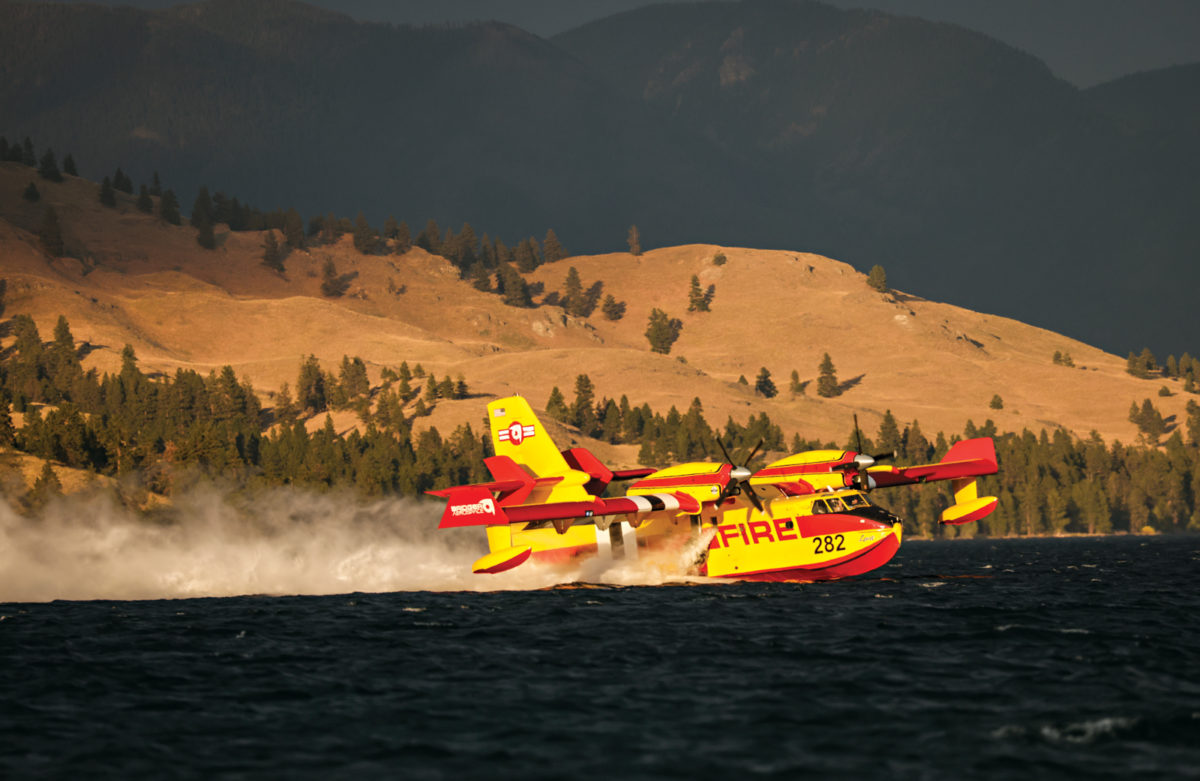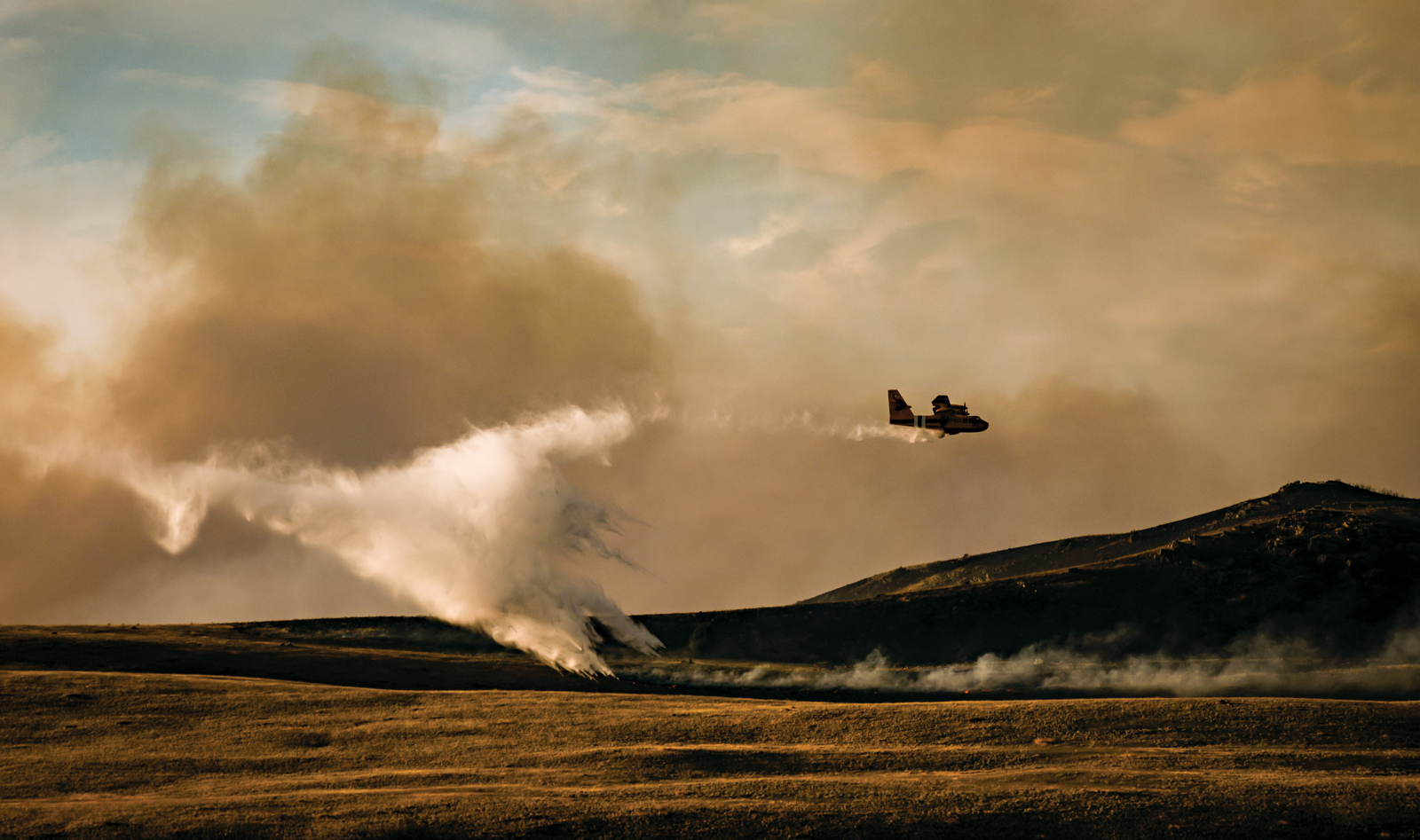The night the Elmo Fire reached Chief Cliff Lane was the closest Lake County Sheriff Don Bell said he’s ever gotten to initiating an emergency evacuation. He and a deputy went door to door along the street where houses are built amid rugged terrain in an elevated area between the communities of Elmo and Dayton.
“I don’t know how far it was, but it is raining ash on us, and it’s dark. It’s so thick with smoke over the top of us. So I knew it was close,” Bell said of the fire. “I mean, if we’d waited 15 minutes people that had been in the house would have burned.”
Mixed in with the falling ash were embers, the sheriff said, and at one home he told a resident they had no more than two minutes before they had to go. There were eight homes on the street that he and the deputy evacuated. By the following day, three of them had burned.
“All there’s left there is concrete and metal. There’s no organic material left,” Bell said of the losses on one property.

As of Aug. 8, when this story went to print, the Elmo Fire had been burning for 11 days, destroyed eight structures, and grown to more than 20,000 acres in size. Hundreds of people have been affected by a combination of evacuation orders and pre-evacuation orders, some of which began to ease last weekend.
The Elmo Fire first ignited on the afternoon of Friday, July 29, less than 10 miles west of the town of Elmo in the Big Draw area off Highway 28, and with hot temperatures and gusting winds out of the west it quickly came to threaten homes to the east. The human-caused fire began just a couple days shy of the one-year anniversary of the human-caused Boulder 2700 Fire, which forced residents of the Polson area to flee in the night as the flames bore down on their homes. The Boulder 2700 Fire, which was later determined to have been caused by arson, destroyed 31 structures, including 14 primary residences.
For those who live in the portions of Lake County and the Flathead Indian Reservation where the Elmo fire has threatened lives and livelihoods, those 11 days since the fire began have brought waves of emotions — fear, optimism, frustration, determination — all ebbing and flowing inside the minds and hearts of those watching the shifting landscape of smoke and flames for a sign of what’s to come.
Ardyce Fowler is still trying to figure out what’s to come for her. Fowler, 73, was among those who lost their homes to the Elmo Fire. She had been living on Chief Cliff Lane for five years, having moved there from California with her husband, Vern. The house they’d lived in was built from logs and stood at the end of a dirt road, and it was a bit worse for wear when they bought it. But they saw something in it, and in the promise of coming to Montana. When Ardyce Fowler talks about their home, she uses the phrase “forever home.” She said her husband did about 80% of the work to fix the place up. The house had views of the lake, and they spent time on the water sailing, kayaking, and building memories as they voyaged through their 70s together.
Last September, Vern Fowler died of a pulmonary embolism at their home. It was the beginning of what Ardyce Fowler has called “a hectic, traumatic year.” She made it through the winter on her own and by the end of it came to feel she was thriving.
“I grew in ways I never would have understood,” she said.
The fire’s destruction left her feeling numb at first.
“Everything is surreal. Literally, it’s like, ‘how can this be?’ And as you’re able to process more, more starts to come in where you have to acknowledge it, and go ‘That’s gone, too.’ The other day I wanted to go to church and I thought, ‘All I have is flipflops. I’ll go home and get some good shoes.’ Oh, no, all I have is flipflops. Everything’s gone.”
Fowler said that her friends, family, church, and others have stepped up “and embraced me, and loved on me, and supported me and I cannot complain. There are people who have lost more than I have.”
“If I can be a help to anyone who’s going through hard times, and they can say ‘an old lady widow can do this, I can do it too,’ then it serves a purpose and it’s not for naught,” Fowler said.
Fowler evacuated the day the fire began. She was able to collect some of her important paperwork, and photographs and a small inventory of other items: a toothbrush, a hairbrush, a few changes of clothing, her father’s Bible, her dog “and a lot of beautiful memories.”
She’s been escorted back to the property once since the fire claimed it. She found the metal roof to her home sitting on the ground, with nothing in between. She took pictures to share with her insurance provider.
Since leaving her home, Fowler has been staying with friends and managed to line up a place to stay through the winter. A GoFundMe launched on her behalf has been a blessing, she said, adding that the most important part hasn’t been the money given, but the love and acknowledgement that she feels from people who have chosen to give. Fowler said she wants to stay in Montana but knows there are challenges to home construction right now, and so she is trying to sort out the best next step.
“This is my home. This is where my heart is. This is where I’ve been blessed, and just because there was a fire doesn’t mean I want to leave,” she said. “If I sat in a puddle of tears and cried and said, ‘woe is me,’ would that make my situation better? No, it would not. So I won’t allow that. I’m not afraid of tears, I don’t think they’re wrong, but right now I have bigger fish to fry.”
At the time the Beacon went to print, the most substantial structure losses had occurred on Monday, Aug. 1; however, firefighters have been hard-pressed at times since, underscoring the fire’s extreme behavior. On Aug. 3, conditions on the fire’s north side reached a point where firefighting personnel had to disengage out of growing safety concerns. On Aug. 4, firefighters encountered their fourth day of red flag conditions as the fire’s northern edge continued to advance on the Lake Mary Ronan area. Just a day earlier, Incident Commander John Thompson had said that, generally, crews don’t see “this many consecutive days in a row of what I could call firefighting that kicks our butt every day.”
Limited demand for firefighting resources elsewhere in the region has left the Elmo Fire well-staffed. At one point, six scooper airplanes were assigned to the fire, which Thompson said was the most he’d ever seen converge on a single fire. Those planes dropped an estimated 600,000 gallons of water on the fire as it backed its way down toward Lake Mary Ronan on Aug. 4, which allowed firefighters to continue building structure protections and keep the fire south of the lake. As of Aug. 8, the fire had 616 personnel assigned, which is up from around 120 the day it began burning.

The weather, at least over last weekend, took a favorable turn for firefighters, who reported the fire on Monday to be 55% contained, which is an increase of 40% in containment from last Friday. From Aug. 5 through Aug. 7, the fire reportedly grew by 163 acres, or about 54 acres a day on average. New containment gains were reported along portions of the fire’s western and eastern sides, to go along with an area along Highway 28 that was already considered contained. Firefighting costs on the Elmo Fire had reached $10.4 million by Sunday, Aug. 7, the most recent estimates available prior to the Beacon’s print deadline.
One of the ongoing priorities for firefighters is to prevent the fire from crossing Lake Mary Ronan Road, especially where it runs east of the lake. Previously, Thompson said he’s concerned by the rugged terrain north of there, where homes are interspersed with a mix of unburnt fuels. The terrain would afford firefighters few opportunities to stop fire movement and, depending on the fire’s progression, the communities of Rollins and Lakeside could wind up on the downwind side of the fire.
At an Aug. 5 community meeting, Operation Sections Chief Phil Knaub said that John Thompson’s Northern Rockies Team 7 Type 2 incident management team had a week left before they reached the conclusion of their assignment, and that if the successes keep adding up, they intend to leave things in good shape for whoever takes over incident command next.
However, firefighters might not gain control of the fire until the end of August or the end of September, according to Knaub, and a significant weather event will need to arrive to snuff it out entirely.
“There’s gonna be heat in here ‘til it snows. There’s likely to be smoke coming out of this fire ‘til it snows, especially on the backside,” Knaub said. “There will be a lot of firefighters out here for the rest of the season.”
Bruce Giersdorf, a fire behavior analyst on the fire, said that the fire hasn’t completely blackened the landscape it has moved through, meaning the area is checkerboarded with unburnt fuels that will continue to dry amid hot days, with no precipitation in the long-term forecast. That is expected to continue driving smoke and some fire activity, including in the fire’s interior.

On Aug. 5, Montana Gov. Greg Gianforte described the Elmo Fire as the top priority fire in the state. For how long it remains that way is uncertain amid a landscape that is growing increasingly susceptible to fire starts and wildland fire spread amid the hot, dry days of August. Flathead and Lake counties both have above-normal significant wildland fire potential forecast for August and September, according to the National Interagency Fire Center’s Predictive Services program.
On Monday, Aug. 8, the Montana Department of Natural Resources and Conservation (DNRC) published a weekly wildfire situation report. The previous week saw firefighters at the state and county level respond to 72 fires that burned 16,218 acres, according to the report.
“Temperatures are on the rise again this week, with strong winds and thunderstorms forecast,” DNRC noted in its report. “With a greater proportion of firefighting resources committed to several large wildfires, it’s more important than ever that Montanans and visitors do your part to prevent human-caused wildfire starts.”
